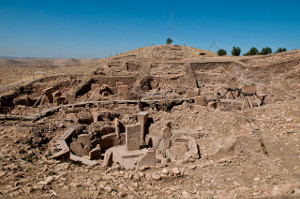
 The megalithic structures of Göbekli Tepe (navel mound) in Turkey - near
the city Urfa - has baffled modern archaeologist after it had been dated
at around 9,500 BC. This means that it would be 5,500 years older than the first cities
of Sumer: the world's earlier oldest known civilization.
The megalithic structures of Göbekli Tepe (navel mound) in Turkey - near
the city Urfa - has baffled modern archaeologist after it had been dated
at around 9,500 BC. This means that it would be 5,500 years older than the first cities
of Sumer: the world's earlier oldest known civilization.
The hill was
used by generations of farmers as farming ground until carved stone
structures were discovered below the sand in the year 1962. The site
had not been officially excavated until 1994, and currently the site
has only been excavated for a merely 1.5%.
Among the
findings there had been found a number of stone walls and many standing
T-shaped stone pillars which vary in weight from 10 to 50 tons. The
tallest stones all face southeast. As with the other ancient megalithic
sites, one has to wonder how they would have carved these heavy stones
and put them into place.
At the sides of the pillars there are reliefs depicting animals
including: lions, bulls, swines, foxes, gazelles, reptiles and birds.
Round potmarks can be seen at the top of a number of those pillars,
which look similar to the potmarks at certain dolmens in Europe.
Perhaps it may be that these pillars originally carried roofs or that
the potmarks contained precious stones.
The purpose
of this site is currently not known, but the general idea is that of
a shrine or temple complex, because it does not have the features of
a city or a place for everyday living. There is evidence that this
place was deliberately buried with sand when this place was
abandoned, for unknown reasons.
Some researchers think that
this site may be the Biblical "Garden of Eden", but psychic
intuitives put the existence of the Garden of Eden within the
Lemurian age - which is far older than the dated 9,500 BC that would
be during the final period of the age of Atlantis. According to Dr.
Douglas James Cottrell, Eden was actually more closely to
Ethiopia.
Dr. Cottrell described Göbekli Tepe as a place of
"great learning and great luxury"; It was an energy place
where there was taken water from the ground that would have curative
influences, and it had a profound sense of peace and tranquillity.
The intention was to destroy it at some point in time, because of its
influence as a power point or part of a grid. (See the chapter:
"Energy
Lines of the Earth".)
(Sources:
"Ezekiel's
wheel, the Garden of Eden, and the Dinosaurs' demise", and
"Dr.
Douglas James Cottrell: Göbleki Tepe - ancient sacred site of the
Middle East, by Rammsteinregeln.)
Nearby
Göbleki Tepe, in an area called Tektek Daglari, there is another
site called Karahan Tepe where also a large number of T-shaped
pillars and stone walls had been uncovered.



